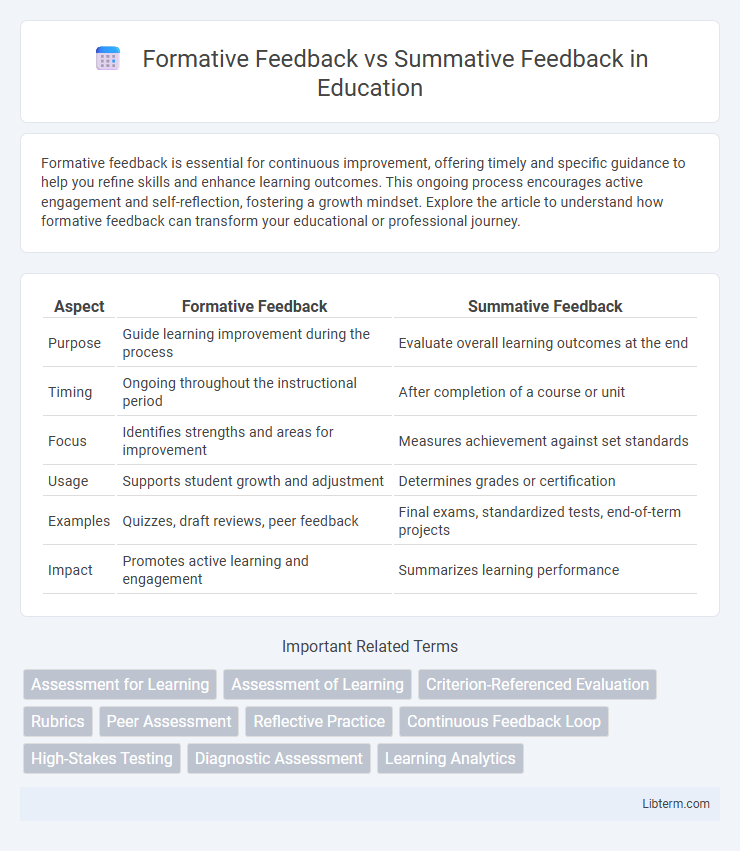Formative feedback is essential for continuous improvement, offering timely and specific guidance to help you refine skills and enhance learning outcomes. This ongoing process encourages active engagement and self-reflection, fostering a growth mindset. Explore the article to understand how formative feedback can transform your educational or professional journey.
Table of Comparison
| Aspect | Formative Feedback | Summative Feedback |
|---|---|---|
| Purpose | Guide learning improvement during the process | Evaluate overall learning outcomes at the end |
| Timing | Ongoing throughout the instructional period | After completion of a course or unit |
| Focus | Identifies strengths and areas for improvement | Measures achievement against set standards |
| Usage | Supports student growth and adjustment | Determines grades or certification |
| Examples | Quizzes, draft reviews, peer feedback | Final exams, standardized tests, end-of-term projects |
| Impact | Promotes active learning and engagement | Summarizes learning performance |
Understanding Formative and Summative Feedback
Formative feedback involves ongoing, interactive assessments that guide learners by identifying strengths and areas for improvement during the learning process. Summative feedback evaluates overall performance at the end of an instructional period, often in the form of grades or final scores. Understanding formative and summative feedback is crucial for optimizing teaching strategies and enhancing student learning outcomes.
Key Differences Between Formative and Summative Feedback
Formative feedback provides ongoing, real-time insights that help learners identify areas for improvement during the learning process, emphasizing growth and development. Summative feedback evaluates overall performance after completion, focusing on assigning grades or final judgments to measure achievement. The key difference lies in timing and purpose: formative aims to guide improvement, while summative assesses final outcomes.
Purposes of Formative Feedback in Learning
Formative feedback in learning primarily aims to guide students' improvement by providing ongoing, specific, and actionable insights during the learning process. It helps identify strengths and areas for growth, enabling learners to adjust strategies and deepen understanding before final assessments. This feedback enhances motivation, supports skill development, and fosters self-regulation, contributing to more effective and personalized learning outcomes.
The Role of Summative Feedback in Assessment
Summative feedback plays a critical role in assessment by providing a comprehensive evaluation of student learning at the end of an instructional period, often influencing final grades and academic progression. It offers clear benchmarks and measurable outcomes that help educators and stakeholders determine the effectiveness of curricula and identify areas for improvement. Unlike formative feedback, summative feedback focuses on certifying achievement rather than guiding ongoing learning processes.
Advantages of Formative Feedback
Formative feedback offers real-time insights that help learners identify strengths and areas for improvement, enhancing skill development throughout the learning process. It promotes active engagement and motivation by encouraging continuous reflection and adjustment, leading to better retention and mastery of content. Unlike summative feedback, which evaluates performance after completion, formative feedback supports adaptive teaching strategies and personalized learning pathways.
Benefits and Limitations of Summative Feedback
Summative feedback provides a clear evaluation of student performance at the end of a learning period, enabling educators to measure achievement against standardized criteria and inform final grades. Its benefits include offering a concise summary of learning outcomes and facilitating accountability in educational settings. However, summative feedback has limitations such as its inability to guide ongoing improvement, lack of immediacy, and potential to create anxiety without opportunities for revision or growth.
Effective Strategies for Implementing Formative Feedback
Formative feedback involves continuous, real-time insights during the learning process, aimed at enhancing student understanding, while summative feedback evaluates performance at the end of an instructional period. Effective strategies for implementing formative feedback include using specific, actionable comments that target learning objectives, incorporating peer assessments to promote collaborative learning, and leveraging digital tools for immediate, personalized responses. Regularly monitoring student progress and adjusting instruction accordingly ensures that formative feedback drives meaningful improvement and fosters a growth mindset.
Best Practices for Delivering Summative Feedback
Effective summative feedback should be clear, specific, and focused on overall performance outcomes, emphasizing strengths and areas for improvement aligned with predefined criteria. Best practices include delivering feedback promptly after assessment, balancing positive reinforcement with constructive critique, and providing actionable recommendations that guide future learning or performance. Maintaining an objective tone and linking feedback to measurable goals enhance the utility and acceptance of summative evaluations.
Integrating Formative and Summative Feedback for Student Success
Integrating formative and summative feedback enhances student success by providing continuous guidance and clear performance benchmarks. Formative feedback offers real-time insights during the learning process, enabling students to adjust and improve, while summative feedback evaluates overall achievement at course completion. Combining these feedback types creates a comprehensive assessment strategy that supports ongoing development and measures final learning outcomes effectively.
Choosing the Right Feedback Type for Different Educational Contexts
Formative feedback, characterized by ongoing, descriptive input, supports student learning through continuous improvement, making it ideal for interactive classroom settings and skill development phases. Summative feedback, delivered as evaluative and final judgments, effectively measures learning outcomes in standardized testing or at the end of instructional units. Selecting the appropriate feedback type depends on educational goals, with formative feedback enhancing engagement and mastery, while summative feedback provides accountability and certification of achievement.
Formative Feedback Infographic

 libterm.com
libterm.com